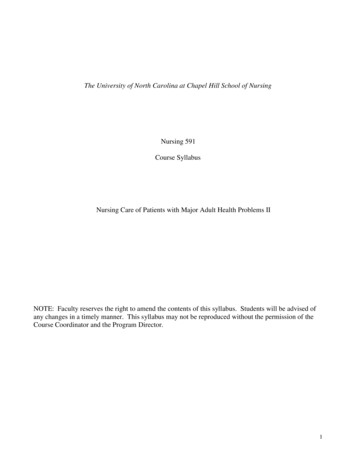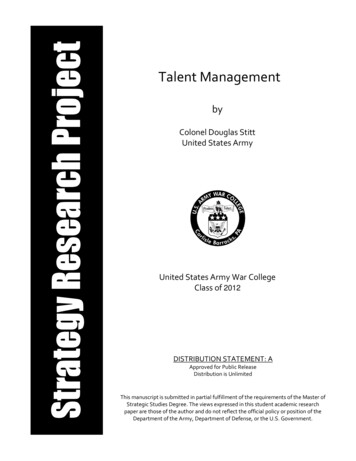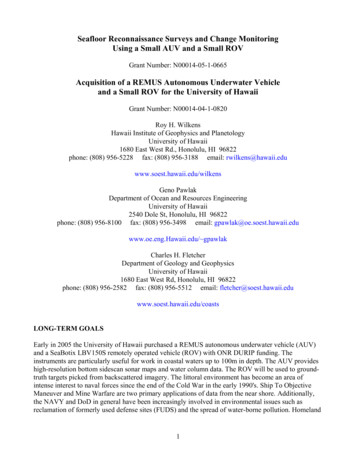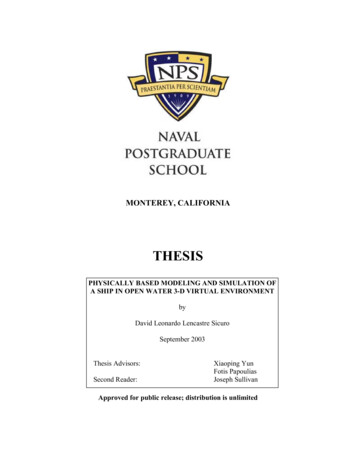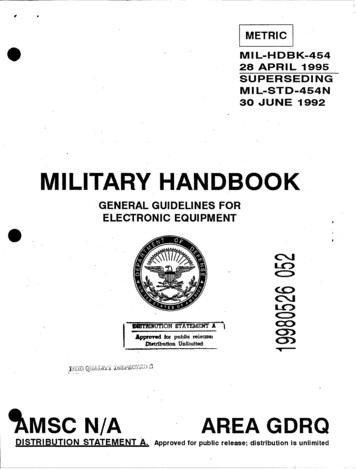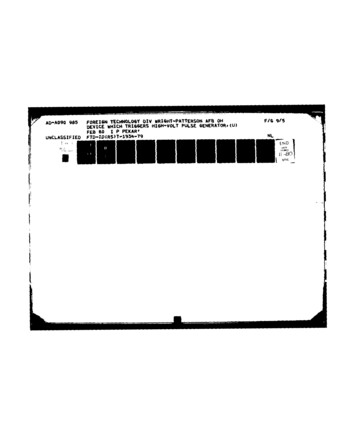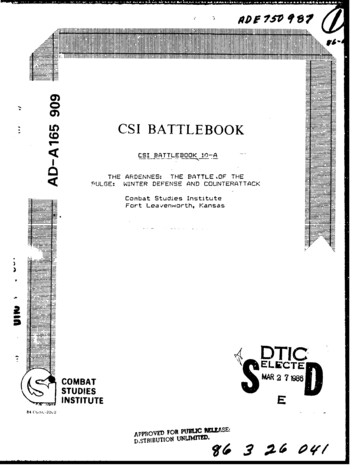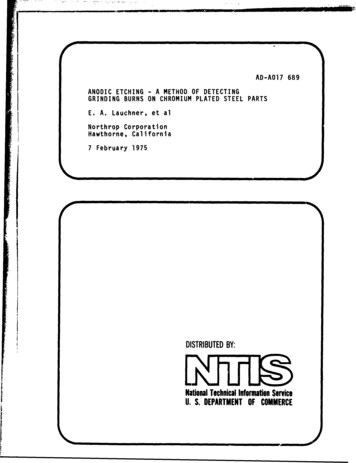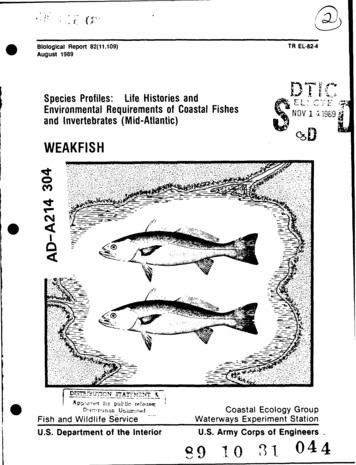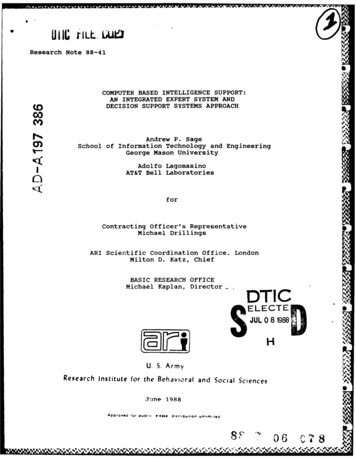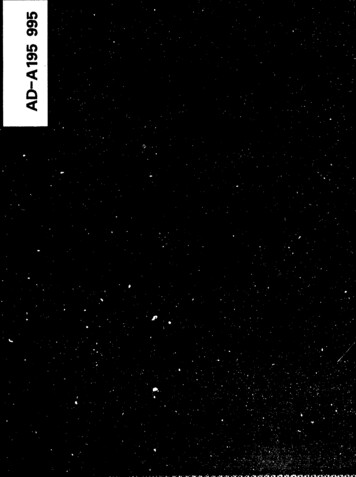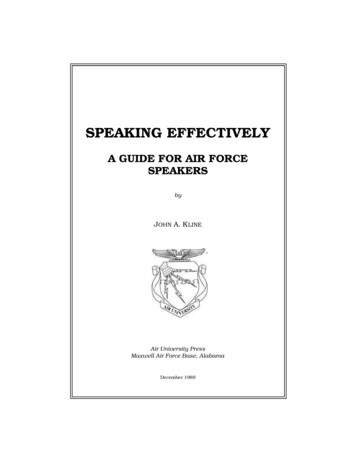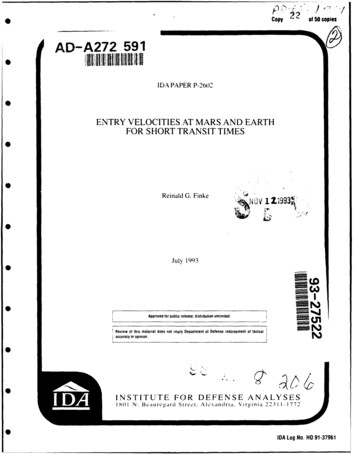
Transcription
Copy22of 50 copiesAD-A272 591IDA PAPER P-260ENTRY VELOCITIES AT MARS AND EARTHFOR SHORT TRANSIT TIMESReinald G. Finke0V l193INJuly 19930Approved for public release: distribution unlimited.S! Review of this material does not imply Department of Defense indorsement of factualaccuracy or opinion.1INSTITUTE FOR DEFENSE ANALYSESI8(1 N.BCaure,,ard Street. Alexandria.Virini223 11 - 1772IDA Log No. HO 91-37951
DEFINITIONSIDA publishes the following documents to report the results of its work.ReportsReports are the most authoritative and most carefully considered products IDA publishes.They normally embody results ot major projects which (a) have a direct bearing ondecisions affecting major programs, (b) address issues of significant concern to theExecutive Branch, the Congress and/or the public, or (c) address issues that havesignificant economic implications. IDAReports are reviewed by outside panels of expertsto ensure their high quality and relevance to the problems studied, and they are releasedby the President of IDA.Group ReportsGroup Reports record the findings and results of IDA established working groups andpanels composed of senior individuals addressing major issues which otherwise would bethe subject of an IDA Report. IDA Group Reports are reviewed by the senior individualsresponsible for the project and others as selected by IDA to ensure their high quality andrelevance to the problems studied, and are released by the President of IDA.PapersPapers, also authoritative and carefully considered products of IDA, address studies thatare narrower in scope than those covered in Reports. IDA Papers are reviewed to ensurethat they meet the high standards expected of refereed papers in professional journals orformal Agency reports.DocumentsIDA Documents are used for the convenience of the sponsors or the analysts (a) to recordsubstantive work done in quick reaction studies. (b) to record the proceedings ofconferences and meetings, (c) to make avaiiable preliminary ;,"d tentative results ofanalyses. (d) to record data developed in the course of an investigation, or (e) to forwardinformation that is essentially unanalyzed and unevaluated. The review of IDA Documentsis suited to their content and intended use.The views expressed in this paper are those of the author and do not reflect the officialpolicy or position of the Department of Defense or the U.S. Government.
DOCUMENTATION PAGESREPORTPbc.Reporting burden ot Ina co f0c0onP.n a0rongS.' ,osMOAoQcarIebOIolnoC .C. . .D.octoZtto.flo0* 0001.0 1. 4 *0lrn ocniOram0onSOp1ooond, Roto9p.g, -pon.1 h.1h. b7221.dn*twoon Do s,0cog o.90.wa000pngMangJrcf-lhC-g-o.6001 WM.,.0oa 0,.S- 0 1204 A- g1on VA 22202 43022. REPORT DATE1. AGENCY USE ONLY (Leave blank)roJuly 1993Form Approv"OMB No. 0704-01880on n,80on.to I. o OtMc. O1 ni n oonondO.C *00o gallhnng .0d ma niamng Ihe cMWtsnlngo,. .atsteoong.o oO I,.0go4000gn ego n t codths b0.donB gogot Pand.to WaaongonRbakoo.i Irobe3. REPORT TYPE AND DATES COVEREDFinal--December 1989-July 19915. FUNDING NUMBERS4. TITLE AND SUBTITLESelf Initiated TaskEntry Velocities at Mars and Earth for Short Transit Times6. AUTHOR(S)Reinald G. Finke7. PERFORMING ORGANIZATION NAME(S) AND ADDRESS(ES)8. PERFORMING ORGANIZATIONREPORT NUMBERInstitute for Defense Analyses1801 N. Beauregard St.Alexandria, VA 22311-1772IDA Paper P-26029. SPONSORING/MONITORING AGENCY NAME( ) AND ADDRESS(ES)10. SPONSORING/MONITORINGAGENCY REPORT NUMBER11. SUPPLEMENTARY NOTES12a. DISTRIBUTIONMAVAILABILITY STATEMENT12b. DISTRIBUTION CODEApproved for public release: distribution unlimited13. ABSTRACT (Maximum 200 words)Propulsion systems composed of a Shuttle External Tank, appropriately modified for the purpose, with a rocketengine that is either an SSME or a NERVA could inject a gross personnel payload of 100,000 lb on a trans-Marstrajectory from Space Station "Freedom" with aerobraking at Mars with transit times of less than 70 days. Suchtransit times reflect a significant reduction from the 200-plus days generally considered. The 100,000-lb payloadwould include the mass of a hypothetical aerobrake for aerocapture at Mars. The entry velocities at Marscompatible with such transit times are greater than 21 km/sec. to be compared with previously stated constraints of8.5 to 9.5 km/sec for nominal Mars entry velocity. Limits of current aerobrake technology are not well enoughdefined to determine the feasibility of an aerobrake to handle Mars-entry velocities for short-transit-time trajectories.Return from Mars to Earth on a mirror image of a 70-day outbound trajectory (consistent with a stay time of about 12days) would require a Mars-departure velocity increment more than twice as great as that at Earth departure andwould r quire a correspondingly more capable propulsion system. The return propulsion system would preferablybe predeployed at Mars by one or more separate minimum-energy, 0.5-to- 1.1 -MIb-gross-payload cargo flights withthe same outbound propulsion systems as the personnel flight, before commitment of the personnel flight.Aerobraking entry velocity at Earth after such a transit time would be about 16 km/sec, to be compared withconstraints set at 12.5 to 16 km/sec.14. SUBJECT TERMS15. NUMBER OF sAGESaerobrake, nuclear propulsion, chemical propulsion, Mars, transit time, externaltank, high-speed reentry17. SECURITY CLASSIFICATIONOF REPORTUNCLASSIFIEDNSN 7540-01-280-550018. SECURITY CLASSIFICATIONOF THIS PAGEUNCLASSIFIED19. SECURITY CLASSIFICATION4116. PRICE CODE20. LIMITATION OF ABSTRACTOF ABSTRACTUNCLASSIFIEDSARStandard Form 298 (Rev 2-89)Prontl.d29610by ANSI StI Z3094
IDA PAPER P-2602ENTRY VELOCITIES AT MARS AND EARTHFOR SHORT TRANSIT TIMESReinald G. FinkeJuly 1993Approved for public release; distribution unlimited.Review of this material does not imply Department of Defense indorsement of factualaccuracy or opinion.SDDAINSTITUTE FOR DEFENSE ANALYSES
FOREWORDThis paper represents the documentation of the analysis that was carried out as partof a self-initiated effort of several STD staff members (R.G. Finke, A. Hull, W. Jeffrey,P. Kysar, and R.S. Swanson) toward providing an IDA product of potential interest toNASA. The effort began in January 1990 after the Space Council announced that it wouldbe soliciting new ideas from non-NASA contributors to help define NASA's SpaceExploration Initiative. Interim results of this work were incorporated in presentations toMr. Michael Weeks of NASA/HQ on September 11, 1990 and to the staff of the SynthesisGroup on January 25, 1991.The author wishes to thank the reviewers of this paper, H. Hagar, W. Jeffrey,R.C. Oliver, and R.S. Swanson, for their many suggestions for improvement of theexposition. ",r'T.FT AQ e vraD? SDTii,.L-.or- A
ABSTRACTPropulsion systems composed of a Shuttle External Tank, appropriately modifiedfor the purpose, with a rocket engine that is either an SSME or a NERVA could inject agross personnel payload of 100,000 lb on a trans-Mars trajectory from Space Station00"Freedom" with aerobraking at Mars with transit times of less than 70 days. Such transittimes reflect a significant reduction from the 200-plus days generally considered. The100,000-lb payload would include the mass of a hypothetical aerobrake for aerocapture atMars. The entry velocities at Mars compatible with such transit times are greater than21 km/sec, to be compared with previously stated constraints of 8.5 to 9.5 krm/sec fornominal Mars entry velocity. Limits of current aerobrake technology are not well enoughdefined to determine the feasibility of an aerobrake to handle Mars-entry velocities forshort-transit-time trajectories.Return from Mars to Earth on a mirror image of a 70-day outbound trajectory(consistent with a stay time of about 12 days) would require a Mars-departure velocityincrement more than twice as great as that at Earth departure, and would requirea correspondingly more capable propulsion system. The return propulsion systemwould preferably be predeployed at Mars by one or more separate minimum-energy,0.5-to-1.1-Mlb-gross-payload cargo flights with the same outbound propulsion system asthe personnel flight, before commitment of the personnel flight. Aerobraking entry velocityat Earth after such a transit time would be about 16 km/sec, to be compared with constraintsset at 12.5 to 16 km/sec.0
CONTENTSF orew ord . iiA bstract . iiiF igures . vT ables . vI.INTRODUCTION . III.D ISC U SSIO N . 4A. Propulsion Systems .4B. Transit Times .6C. Propulsion-System Performance . 18III.D. Entry Velocities .22OBSERVATIONS .27REFERENCES .29APPENDIX A-- Calculation of Time of Orbital Motion:Function TIME(P, e, 0) . A-Iiv
FIGURES1External Tank to Scale of Proposed Mars Transportation System(N A SA , 1989) . 52.Departure from Earth Orbit . 73.Types of Transfer Trajectu, ies .4.Typical Parabolic Flight Profile to Mars (illustrating "sprint" possibility) . 125.Stay Time at Mars between Outbound and Return Transferswith Equal Transit Times (coplanar circular orbits; perihelion at Earth) . 136.Velocity Requirement Versus Transit Time to Mars from Space Station"Freedom" to Mars' Orbit (coplanar circular orbits) . 157.Velocity Requirement Versus Transit Time to Earth from Phobos toEarth's Orbit (coplanar circular orbits) . 178.Transit Time to Mars as a Function of Trans-Mars Payload for Single-ET,Single-EnginePropulsion Systems from "Freedom" (coplanar circular orbits;for aerobraking at Mars to Phobos, reduce plotted payload by aerobrakemass and propellant mass for circularization after aerocapture) . 209.Mars Entry Velocity as Function of Transit Time to Mars (coplanarcircular orbits; non-rotating atmosphere) . 2410.Earth Entry Velocity as Function of Transit Time to Earth (coplanarcircular orbits; non-rotating atmosphere) . 259TABLES1.Assumed Properties of Propulsion Systems . 62.Propulsion Systems' Capabilities (Injection from Space Station "Freedom"into trans-Mars Trajectory with Aerocapture at Mars) . 213.Entry Velocities at Mars and Earth for Selected Transit Times(Mars entry altitude 48 kIn; Earth entry altitude 121.9 km) . 26V
I.INTRODUCTIONIn discussions of human flight to Mars, the observation is often made that theduration of the trip from one planet to the other ("transit time") should be made short toreduce the time of exposure of the crew to the rigors and hazards of space, such as lowgravity, space radiation, confinement and isolation, and possible support-systemmalfunctions. However, as the transit time is shortened, there is an increase in the velocityincrement (AV) demanded from the propulsion system. Inspection of the "rocket equation"AV gc Isp InMMpayloadinertpayloadwhere gc is the conversion of mass units to force units, Isp is the propulsion system'sspecific impulse (thrust per unit mass flow rate) and M is mass, indicates that an increase inAV can be obtained by an increase in Isp and/or an increase in the mass ratio (the quantity inparentheses).It is often asserted (e.g., see Synthesis, 1991) that nuclear propulsion is necessaryif short transit times are to be achieved. While nuclear propulsion has a greater Isp thanchemical propulsion, the nuclear rocket engine has a greater mass than the chemical rocketengine, increasing the inert mass (which is typically small in comparison with thepropellant mass) and decreasing the mass ratio; further, the liquid-hydrogen propellant forthe nuclear rocket engine has a lower density than the liquid-oxygen/liquid-hydrogenpropellants of the chemical rocket engine, lowering the propellant mass, if propellantvolume were constrained, and again decreasing the mass ratio. These countervailing trendsin lsp and mass ratio make the relative performance of nuclear propulsion with respect tochemical propulsion not intuitively obvious, but dependent on the actual values going intothe rocket equation.If an aerobrake could be employed instead of a propulsive maneuver to decelerate atMars, the velocity decrement provided by the aerobrake could be regarded as an increase inthe overall AV capability of the system, and the propellant saved by aerocapture at Marscould be added to the propellant of the main propulsion stage to be used for departure fromEarth. This increase in departure propellant would ostensibly generate a higher departureI
speed and therefore a shorter transit time, and the main propulsion stage could be jettisonedafter the departure impulse so that no insulation of cryogenic propellant(s) against boiloffduring the months of outbound transfer would be needed. However, the mass of theaerobrake must come out of the payload mass, or, if payload mass is fixed, will increasethe inert mass (an increase that is partially offset by the decreased tank-insulationrequirement), decreasing the mass ratio and reducing the gain in departure AV produced bythe gain in departure propellant. Again, as with nuclear propulsion, the relativeperformance with or without an aerobrake depends on the actual design values going intothe rocket equation; a sufficiently great aerobrake mass could wipe out the benefit ofincreased propellant at Earth departure. If aerobrake mass increases with entry velocity(while entry velocity is increasing as transit time is shortened), then beyond some value ofentry velocity an increase in entry velocity will lead to a greater increase in aerobrake massthan the mass of propellant required to cancel propulsively that increase in entry velocity.In a lack of understanding of heating rates and thermal protection systems at high entryvelocities, an aerobrake designer could increase his aerobrake's entry-velocity capabilitiessimply by adding more ablative material, increasing the aerobrake's mass possiblyunnecessarily.The required aerobrake technology is set by the capability of the propulsion systemto generate high departure AVs for short transit times. Low propulsion-system capability,compatible with minimum-energy transfer requirements set by planners who are overconcerned with the costs of generating high propulsive AV, leads to low aerobraketechnology demands, and there is no motivation to advance aerobrake technology. On theother hand, if currently expressed constraints set on aerobrake entry velocities representtechnology barriers, the designers of propulsion systems have no motivation to providehigher AVs.The principal purpose of this analysis was to determine whether the limitation toachievement of short transit times is set by propulsion-system technology or by aerobraketechnology. The approach taken here to resolvina this question follows the procedurebelow:We build on "existing" propulsion-system components to determine the resultingdependences of transit time and entry velocity on payload weight, i.e., we-1.Define credible example propulsion systems,2.Determine AV requirements that are to be satisfied by these propulsion systemsfor different transit times,2
3.Find the dependence of transit time on payload for the defined propulsionsystems, assuming that all the destination deceleration can be supplied by anaerobrake, with thb aeiobrake mass included in the payload mass, and4.Find the dept, .ence of entry velocity on transit time.This approach allows us to determine the aerobrake entry-velocity capabilities thatwould be required in order to handle, without propulsive assist, Mars and Earth entries forshort tr'.nsit-time trajectories producible by currently available propulsion-system designswith payload (including aerobrake) masses covering a reasonable range of missions. Theserequired entry-velocity capabilities can then be compared with current statements settingaerobrake entry-velocity limits at the two planets.The determination of entry heating rates at high entry velocities at Mars is a subjectof future experimentation and CFD computation, and the design of thermal protectionsystems capable of withstanding these heating rates may require advancement of the state ofthe art of refractory materials. The derivation of the dependence of aerobrake mass onentry velocity is beyond the scope of this Paper.3
II.DISCUSSIONA. PROPULSION SYSTEMSTo determine whether a choice must be made between a chemical and a nuclearpropulsion system on the basis of ability to achieve short transit times, we consider oneexample of each system. Both of these examples are composed of components of existingdesign to avoid questions of their achievability. Each makes use of the Shuttle's ExternalTank (ET), see Fig. 1, modified as needed, to carry the propellant(s), with a single rocketengine. The cheituical engine chosen is the operational Space Shuttle Main Engine (SSME),and the nuclear engine is the Nuclear Engine for Rocket Vehicle Application (NERVA), adetailed solid-core-reactor paper design of the late 1960s.The assumed values of engine thrust, mass and specific impulse for the SSME andNERVA are given in Table 1. The SSME characteristics for its existing area expansionratio, E, of 80:1 are from JSC, 1990. The NERVA engine mass is taken at the optimisticend of the range of estimates produced in design studies in the 1960s (cited in IDA, 1970),and the mass of a shield to protect the payload from the radiation from the operating reactoris not included in the engine mass, but could be viewed as part of the payload. The 850sec specific impulse adopted here for NERVA is greater than the 825 sec projected in the1960s for applications involving repeated or extended use (as approximated by a one-hourplus burn time--see table) but less than the 900 sec projected at that time (op. cit.) foremployment in a brief single-use mode. The degradation in specific impulse of theNERVA engine associated with running at less than operating temperature during the heatup phase (IDA, 1970) is ignored. The combined mass of the operating subsystems, themanifolding, and the structure to attach the engine and the payload to the ET is taken here tobe 13,000 lb, conservatively about twice the mass of those components determined by theDESIGN launch-vehicle synthesis model in IDA, 1966.Below the SSME data in the table are given the properties of the existing ETcarrying LO2/LH 2 propellants, i.e., its inert mass, propellant volume, average propellantdensity at the specified mixture ratio (six pounds of L0 2 for each pound of LH 2 ) and the4
PROPELLANT FEEDSPRESSURIZATIONLINESET/ORBITERINTEGRALET/SRB FORWARD ATTACHETtOReITERATTACHNAFTLIQLLIQUIDOXYGENVENT VALVEAND FAIRINGLIQUIDHYDROGEN7ýTNUIDU;OOXYGENINTEN
"Freedom" with aerobraking at Mars with transit times of less than 70 days. Such transit times reflect a significant reduction from the 200-plus days generally considered. The 0 100,000-lb payload would include the mass of a hypothetical aerobrake for aerocapture at Mars.
